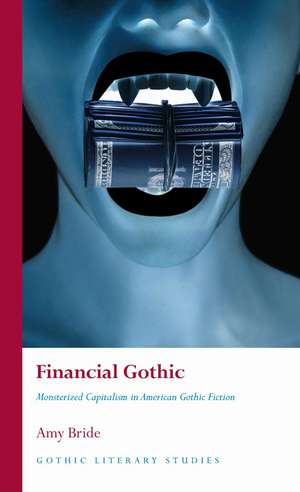Financial Gothic: Monsterized Capitalism in American Gothic Fiction: Gothic Literary Studies
Autor Amy Brideen Limba Engleză Hardback – 23 ian 2024
Financial Gothic reads Frankensteinian monsters, haunted houses, vampires, and zombies in American fiction and film as cultural responses to financial phenomena from 1886 to the present day. The study also considers the preexisting consensus on racial readings of American gothic fiction, and how these interpretations of the slave trade can be expanded upon in conversation with their financial contexts.
Din seria Gothic Literary Studies
-
 Preț: 191.14 lei
Preț: 191.14 lei - 11%
 Preț: 508.60 lei
Preț: 508.60 lei - 11%
 Preț: 508.34 lei
Preț: 508.34 lei - 11%
 Preț: 508.34 lei
Preț: 508.34 lei - 23%
 Preț: 519.74 lei
Preț: 519.74 lei - 11%
 Preț: 509.27 lei
Preț: 509.27 lei - 15%
 Preț: 457.24 lei
Preț: 457.24 lei - 11%
 Preț: 543.42 lei
Preț: 543.42 lei - 23%
 Preț: 515.00 lei
Preț: 515.00 lei - 8%
 Preț: 529.50 lei
Preț: 529.50 lei - 8%
 Preț: 529.28 lei
Preț: 529.28 lei - 8%
 Preț: 529.50 lei
Preț: 529.50 lei - 8%
 Preț: 529.81 lei
Preț: 529.81 lei - 8%
 Preț: 494.30 lei
Preț: 494.30 lei - 11%
 Preț: 507.28 lei
Preț: 507.28 lei -
 Preț: 100.81 lei
Preț: 100.81 lei - 12%
 Preț: 190.72 lei
Preț: 190.72 lei - 20%
 Preț: 484.32 lei
Preț: 484.32 lei - 20%
 Preț: 517.99 lei
Preț: 517.99 lei - 16%
 Preț: 579.51 lei
Preț: 579.51 lei - 21%
 Preț: 578.97 lei
Preț: 578.97 lei - 10%
 Preț: 484.87 lei
Preț: 484.87 lei - 15%
 Preț: 484.87 lei
Preț: 484.87 lei - 10%
 Preț: 484.32 lei
Preț: 484.32 lei - 10%
 Preț: 483.86 lei
Preț: 483.86 lei - 10%
 Preț: 484.32 lei
Preț: 484.32 lei - 14%
 Preț: 837.56 lei
Preț: 837.56 lei - 15%
 Preț: 549.03 lei
Preț: 549.03 lei - 15%
 Preț: 549.03 lei
Preț: 549.03 lei - 11%
 Preț: 543.42 lei
Preț: 543.42 lei
Preț: 529.50 lei
Preț vechi: 575.55 lei
-8% Nou
Puncte Express: 794
Preț estimativ în valută:
101.32€ • 108.35$ • 84.48£
101.32€ • 108.35$ • 84.48£
Carte disponibilă
Livrare economică 28 martie-11 aprilie
Livrare express 13-19 martie pentru 31.83 lei
Preluare comenzi: 021 569.72.76
Specificații
ISBN-13: 9781837720637
ISBN-10: 1837720630
Pagini: 280
Ilustrații: 7 halftones
Dimensiuni: 140 x 216 x 23 mm
Greutate: 0.48 kg
Editura: University of Wales Press
Colecția University of Wales Press
Seria Gothic Literary Studies
ISBN-10: 1837720630
Pagini: 280
Ilustrații: 7 halftones
Dimensiuni: 140 x 216 x 23 mm
Greutate: 0.48 kg
Editura: University of Wales Press
Colecția University of Wales Press
Seria Gothic Literary Studies
Notă biografică
Amy Bride is a lecturer in American studies at the University of Manchester.
Cuprins
Acknowledgements
List of Figures
Introduction: Gothic Finance and Financial Gothic
Chapter One: ‘It’s Alive!’: The 1929 Wall Street Crash and Pulp/Popular/Political Monsters
Chapter Two: ‘The Evil is the House Itself’: Credit, Citizenship, and the Postwar Haunting House
Chapter Three: Deregulation Sucks: Mass Consumption of Liquidity and the Deregulated Vampire
Chapter Four: ‘Myself is Fabricated, An Aberration’: LateCapitalism and the Hyperreal Vampire
Chapter Five: Mindless Consumers: The 2008 Crash and the PostMillennial Zombie
Conclusion: Monsterized Capitalism and Capitalist Monsters
Works Cited
Glossary of Financial Terms
List of Figures
Introduction: Gothic Finance and Financial Gothic
Chapter One: ‘It’s Alive!’: The 1929 Wall Street Crash and Pulp/Popular/Political Monsters
Chapter Two: ‘The Evil is the House Itself’: Credit, Citizenship, and the Postwar Haunting House
Chapter Three: Deregulation Sucks: Mass Consumption of Liquidity and the Deregulated Vampire
Chapter Four: ‘Myself is Fabricated, An Aberration’: LateCapitalism and the Hyperreal Vampire
Chapter Five: Mindless Consumers: The 2008 Crash and the PostMillennial Zombie
Conclusion: Monsterized Capitalism and Capitalist Monsters
Works Cited
Glossary of Financial Terms
Recenzii
"Financial Gothic is a bold disinterment of the monstrosity that has long lain at the core of imaginative responses to money and markets in American culture. In Amy Bride’s incisive analysis, both American Gothic and American capitalism are revealed to be possessed by phantoms still stranger and more potent than we knew."
"Financial Gothic persuasively highlights the immense and often monstrous role that anxieties related to finance and the financial markets have played in shaping the popular American Gothic, between the early twentieth century and the present day."
"This book is a credit to the Gothic’s aptness for denouncing social injustice. Taking stock of the mode’s investment in decrying capitalism’s structural inequalities, Bride argues for a broader consideration of the evolution of financial discourse in the American context as essentially monstrous. When money talks, the Gothic claps back."
"Financial Gothic provides a compelling analysis of how twentieth-century gothic literature is haunted by the twinned histories of finance and slavery. The shadow world of finance is often spectral, and Amy Bride demonstrates how American literature grapples with the problem of 'zombie capitalism.'"
